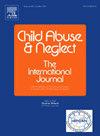作为一种虐待儿童形式的儿童酷刑:对 42 名罪犯调查方面的探索性研究。
IF 3.4
2区 心理学
Q1 FAMILY STUDIES
引用次数: 0
摘要
背景:酷刑历来被描述为出于政治动机的虐待。在家庭环境中对儿童实施酷刑的现象研究较少,学术文章主要集中在法律或医学观点上。从一线专业人员的角度进行分析的文献几乎没有:本研究旨在确定儿童酷刑的共同特征,帮助执法、医疗和儿童保护机构更早地识别儿童酷刑,并提供更有效的调查和干预策略:本研究采用便利抽样法,以识别和收集与酷刑一致的严重虐待儿童案件。样本包括 42 名罪犯和 35 名受害者,代表 20 个家庭:研究人员审查并提取了执法案件档案中的数据,包括调查、医疗和儿童保护服务(CPS)报告,以及执法人员对犯罪者/证人的访谈记录和儿童法医访谈记录。研究生成了描述性统计和频率统计:犯罪者通常为女性(57%),最常见的是亲生母亲(38%),有暴力史(57%)。85% 的案件曾有 CPS 报告,其中不到一半得到证实。在一半以上的案件中(55%),执法部门发现了有关酷刑的数字文档。一半以上(54%)的受害者死于酷刑:这项研究表明,CT 是一种独特的儿童虐待形式,其严重性和普遍性尤为突出。识别、评估和记录身体和心理虐待的独特组合是有效干预的关键。本文章由计算机程序翻译,如有差异,请以英文原文为准。
Child torture as a form of child abuse: An exploratory study of investigative aspects among 42 offenders
Background
Torture has traditionally been described in the context of politically motivated abuse. Torture of children in the familial context is a less studied phenomenon, with scholarly articles focused on legal or medical viewpoints. Analysis from a frontline professional's perspective is virtually nonexistent in the literature.
Objective
The present study seeks to identify the common features of child torture and assist law enforcement, medical, and child protection agencies in earlier identification and inform more effective investigative and intervention strategies.
Participants and setting
A convenience sampling method was used to identify and collect cases involving severe child maltreatment consistent with torture. The sample included 42 offenders and 35 victims, representing 20 households.
Methods
Researchers reviewed and extracted data from law enforcement case files, to include investigative, medical, and child protective services (CPS) reports, as well as recorded law enforcement interviews of offenders/witnesses and child forensic interviews. Descriptive and frequency statistics were generated.
Results
Offenders were often female (57 %), most commonly biological mothers (38 %), with a history of violence (57 %). Prior CPS reports were noted in 85 % of cases, less than half of which were substantiated. In over half of the cases (55 %), law enforcement discovered digital documentation of the torture. Over half (54 %) of the victims died as a result of the torture.
Conclusions
This study demonstrated how CT is a distinct form of child maltreatment that is especially severe and pervasive. Recognition, assessment and documentation of the unique constellation of physical and psychological abuse are key to an efficient intervention.
求助全文
通过发布文献求助,成功后即可免费获取论文全文。
去求助
来源期刊

Child Abuse & Neglect
Multiple-
CiteScore
7.40
自引率
10.40%
发文量
397
期刊介绍:
Official Publication of the International Society for Prevention of Child Abuse and Neglect. Child Abuse & Neglect The International Journal, provides an international, multidisciplinary forum on all aspects of child abuse and neglect, with special emphasis on prevention and treatment; the scope extends further to all those aspects of life which either favor or hinder child development. While contributions will primarily be from the fields of psychology, psychiatry, social work, medicine, nursing, law enforcement, legislature, education, and anthropology, the Journal encourages the concerned lay individual and child-oriented advocate organizations to contribute.
 求助内容:
求助内容: 应助结果提醒方式:
应助结果提醒方式:


